tow INFINITI FX 2013 Owner's Guide
[x] Cancel search | Manufacturer: INFINITI, Model Year: 2013, Model line: FX, Model: INFINITI FX 2013Pages: 522, PDF Size: 7.53 MB
Page 495 of 522

9-16Technical and consumer information
of the load (passengers and car-
go) for the vehicle. This is the
maximum combined weight of
occupants and cargo that can be
loaded into the vehicle. If the
vehicle is used to tow a trailer,
the trailer tongue weight must be
included as part of the cargo load.
This information is located on the
Tire and Loading Information la-
bel.
.Cargo capacity - permissibleweight of cargo, the weight of
total occupants weight subtracted
from the load limit.
STI0445
Page 498 of 522
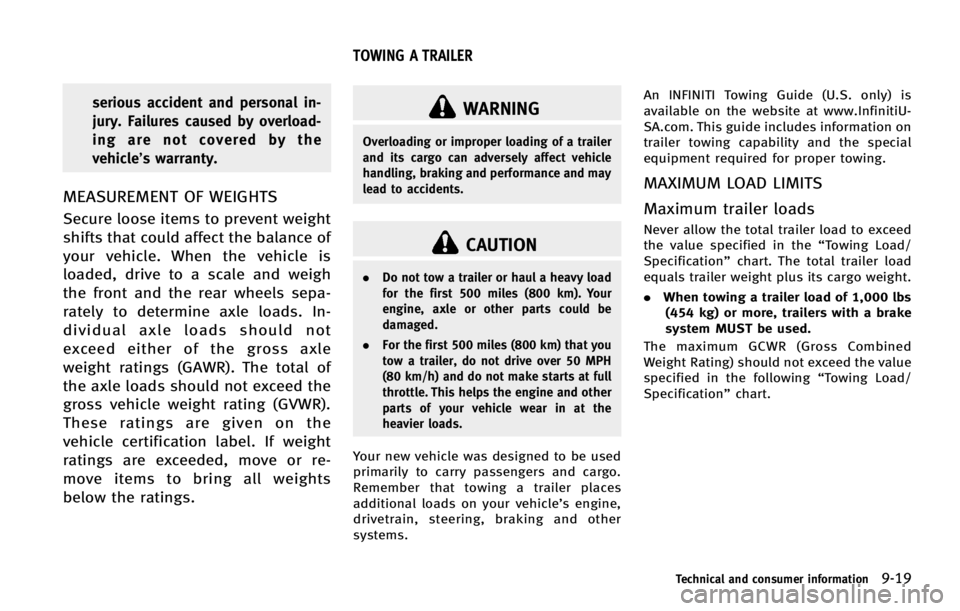
WARNING
Overloading or improper loading of a trailer
and its cargo can adversely affect vehicle
handling, braking and performance and may
lead to accidents.
CAUTION
.Do not tow a trailer or haul a heavy load
for the first 500 miles (800 km). Your
engine, axle or other parts could be
damaged.
. For the first 500 miles (800 km) that you
tow a trailer, do not drive over 50 MPH
(80 km/h) and do not make starts at full
throttle. This helps the engine and other
parts of your vehicle wear in at the
heavier loads.
Your new vehicle was designed to be used
primarily to carry passengers and cargo.
Remember that towing a trailer places
additional loads on your vehicle’s engine,
drivetrain, steering, braking and other
systems. An INFINITI Towing Guide (U.S. only) is
available on the website at www.InfinitiU-
SA.com. This guide includes information on
trailer towing capability and the special
equipment required for proper towing.
MAXIMUM LOAD LIMITSGUID-9B8464D7-BFCF-4992-A6FF-2717C900F8FC
Page 499 of 522
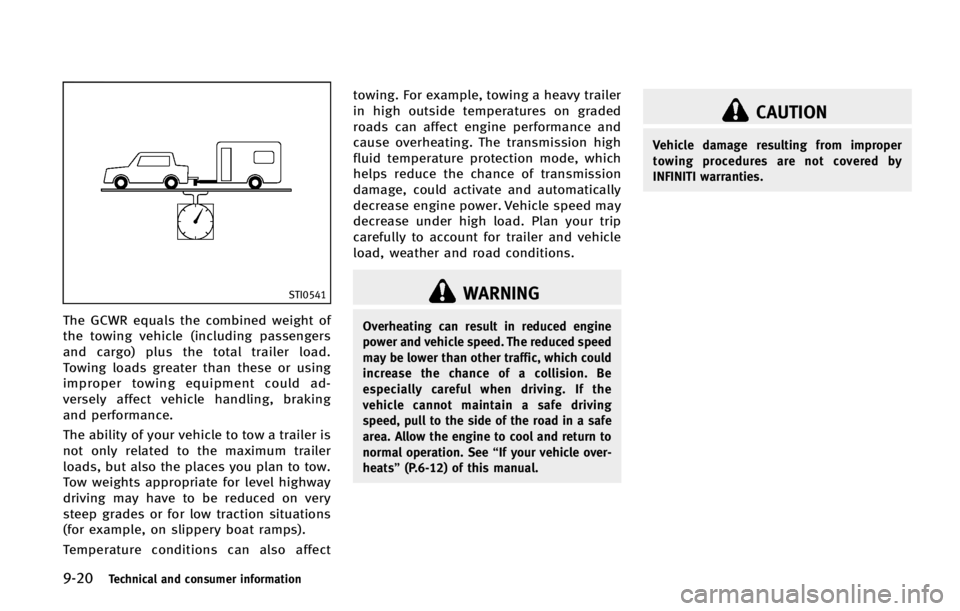
9-20Technical and consumer information
STI0541
The GCWR equals the combined weight of
the towing vehicle (including passengers
and cargo) plus the total trailer load.
Towing loads greater than these or using
improper towing equipment could ad-
versely affect vehicle handling, braking
and performance.
The ability of your vehicle to tow a trailer is
not only related to the maximum trailer
loads, but also the places you plan to tow.
Tow weights appropriate for level highway
driving may have to be reduced on very
steep grades or for low traction situations
(for example, on slippery boat ramps).
Temperature conditions can also affecttowing. For example, towing a heavy trailer
in high outside temperatures on graded
roads can affect engine performance and
cause overheating. The transmission high
fluid temperature protection mode, which
helps reduce the chance of transmission
damage, could activate and automatically
decrease engine power. Vehicle speed may
decrease under high load. Plan your trip
carefully to account for trailer and vehicle
load, weather and road conditions.
WARNING
Overheating can result in reduced engine
power and vehicle speed. The reduced speed
may be lower than other traffic, which could
increase the chance of a collision. Be
especially careful when driving. If the
vehicle cannot maintain a safe driving
speed, pull to the side of the road in a safe
area. Allow the engine to cool and return to
normal operation. See
“If your vehicle over-
heats” (P.6-12) of this manual.
CAUTION
Vehicle damage resulting from improper
towing procedures are not covered by
INFINITI warranties.
Page 501 of 522

9-22Technical and consumer information
available maximum tongue load.
To determine the available towing capacity,
use the following procedure.
1. Find the GCWR for your vehicle on the “Towing Load/Specification” chart
found later in this section.
2. Subtract the actual vehicle weight from the GCWR. The remaining amount is the
available maximum towing capacity.
To determine the Gross Trailer Weight,
weigh your trailer on a scale with all
equipment and cargo, that are normally
in the trailer when it is towed. Make sure
the Gross trailer weight is not more than
the Gross Trailer Weight Rating shown on
the trailer and is not more than the
calculated available maximum towing ca-
pacity.
Also weigh the front and rear axles on the
scale to make sure the Front Gross Axle
Weight and Rear Gross Axle Weight are not
more than Front Gross Axle Weight and
Rear Gross Axle Weight on the F.M.V.S.S./C.
M.V.S.S. certification label. The cargo in the
trailer and vehicle may need to be moved
or removed to meet the specified ratings. Example:
.
Gross Vehicle Weight (GVW) as weighed
on a scale - including passengers,
cargo and hitch - 5,073 lb. (2,301 kg).
. Gross Vehicle Weight Rating (GVWR)
from F.M.V.S.S./C.M.V.S.S. certification
label - 5,301 lb. (2,404 kg).
. Gross Combined Weight Rating (GCWR)
from “Towing Load/Specification” chart
- 7,355 lb. (3,336 kg).
. Maximum Trailer towing capacity from
“Towing Load/Specification” chart -
2,000 lb. (907 kg).
5,301 lb. (2,404 kg) GVWR
− 5,073 lb. (2,301 kg) GVW
= 228 lb. (103 kg) Available for tongue
weight
7,355 lb. (3,336 kg) GCWR
− 5,073 lb. (2,301 kg) GVW
= 2,282 lb. (1,035 kg) Capacity available for
towing
228 lb. (103 kg) / Available tongue weight
2,282 lb. (1,035 kg) Available capacity = 10 % tongue weight
The available towing capacity may be less
than the maximum towing capacity due to the passenger and cargo load in the
vehicle.
Remember to keep trailer tongue weight
between 10 to 15% of the trailer weight. If
the tongue load becomes excessive, re-
arrange the cargo to obtain the proper
tongue load. Do not exceed the 10 to 15%
tongue weight specification even if the
calculated available tongue weight is
greater than 15%. If the calculated tongue
weight is less than 10%, reduce the total
trailer weight to match the available
tongue weight.
Always verify that available capacities are
within the required ratings.
Page 502 of 522
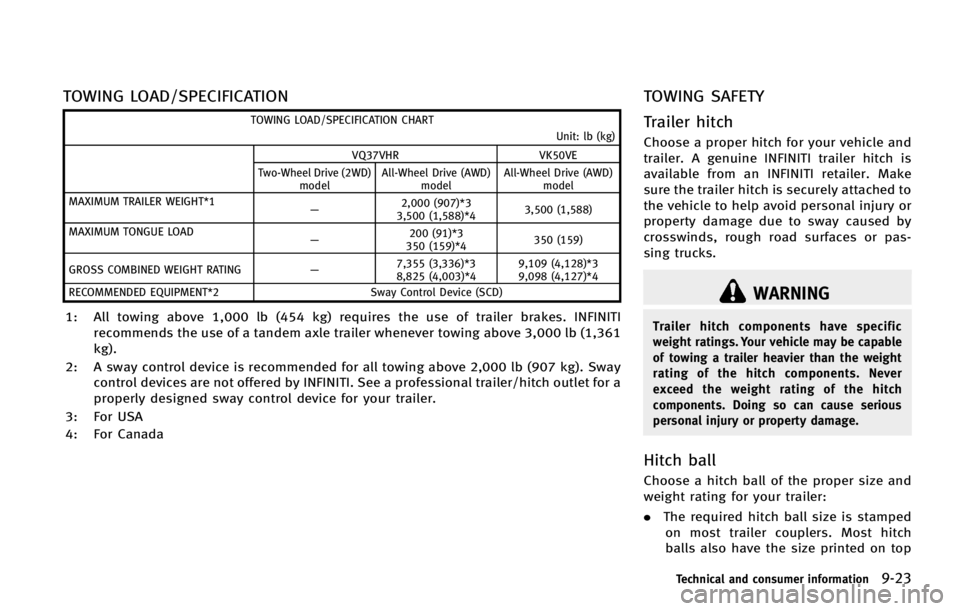
WARNING
Trailer hitch components have specific
weight ratings. Your vehicle may be capable
of towing a trailer heavier than the weight
rating of the hitch components. Never
exceed the weight rating of the hitch
components. Doing so can cause serious
personal injury or property damage.
Hitch ballGUID-CE674953-BE52-413E-A9FF-B7F163CBF1B0
Page 503 of 522
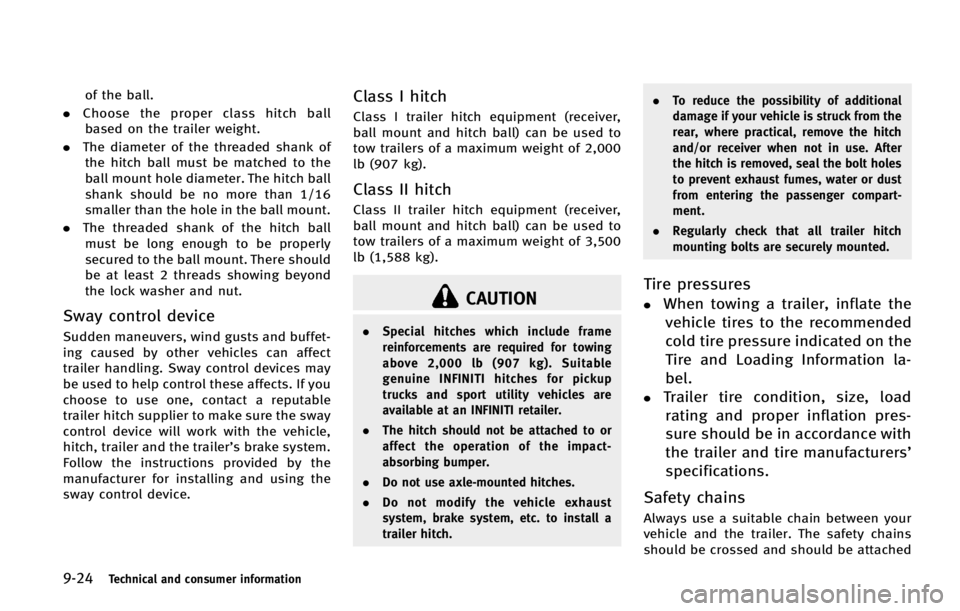
9-24Technical and consumer information
CAUTION
.Special hitches which include frame
reinforcements are required for towing
above 2,000 lb (907 kg). Suitable
genuine INFINITI hitches for pickup
trucks and sport utility vehicles are
available at an INFINITI retailer.
. The hitch should not be attached to or
affect the operation of the impact-
absorbing bumper.
. Do not use axle-mounted hitches.
. Do not modify the vehicle exhaust
system, brake system, etc. to install a
trailer hitch. .
To reduce the possibility of additional
damage if your vehicle is struck from the
rear, where practical, remove the hitch
and/or receiver when not in use. After
the hitch is removed, seal the bolt holes
to prevent exhaust fumes, water or dust
from entering the passenger compart-
ment.
. Regularly check that all trailer hitch
mounting bolts are securely mounted.
Tire pressuresGUID-013B90D6-E075-4F27-B32E-0E2F49F9243C
Page 504 of 522
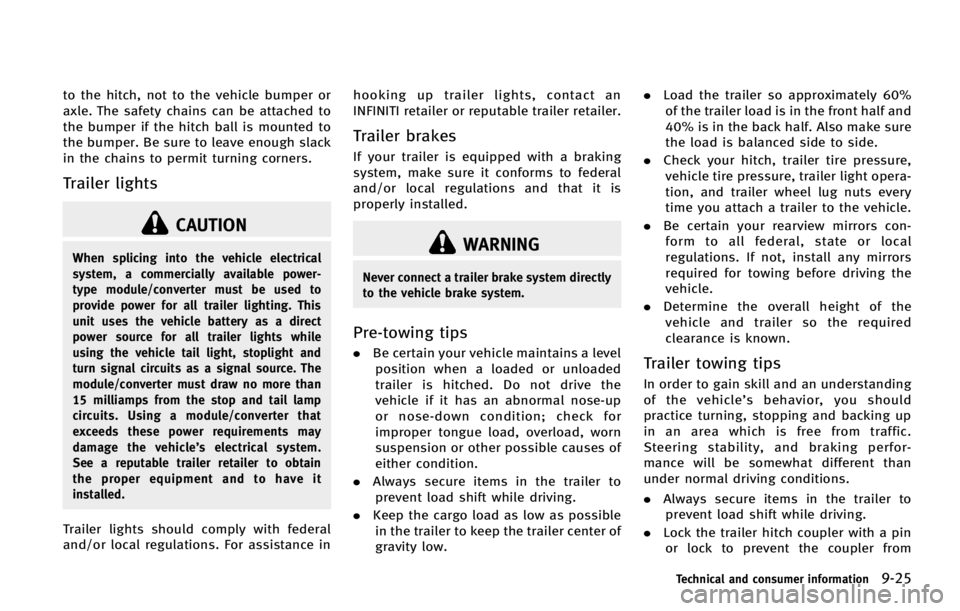
CAUTION
When splicing into the vehicle electrical
system, a commercially available power-
type module/converter must be used to
provide power for all trailer lighting. This
unit uses the vehicle battery as a direct
power source for all trailer lights while
using the vehicle tail light, stoplight and
turn signal circuits as a signal source. The
module/converter must draw no more than
15 milliamps from the stop and tail lamp
circuits. Using a module/converter that
exceeds these power requirements may
damage the vehicle’s electrical system.
See a reputable trailer retailer to obtain
the proper equipment and to have it
installed.
Trailer lights should comply with federal
and/or local regulations. For assistance inhooking up trailer lights, contact an
INFINITI retailer or reputable trailer retailer.
Trailer brakesGUID-7D6F63F5-C497-4498-A3A7-FFED19AE74DC
WARNING
Never connect a trailer brake system directly
to the vehicle brake system.
Pre-towing tipsGUID-A9F812AA-6192-4A97-A335-073B5E83EAD3
Page 505 of 522

9-26Technical and consumer information
CAUTION
If you move the shift selector lever to the P
(Park) position before blocking the wheels
and applying the parking brake, transmis-
sion damage could occur.
1. Apply and hold the brake pedal.
2.Have someone place blocks on the
downhill side of the vehicle and trailer
wheels.
3. After the wheel blocks are in place, slowly release the brake pedal until the
blocks absorb the vehicle load.
4. Apply the parking brake.
5. Shift the transmission into P (Park).
6. Turn off the engine.
To drive away:
1. Apply and hold the brake pedal.
2. Start the engine.
3. Shift the transmission into gear.
4. Release the parking brake.
5. Drive slowly until the vehicle and trailer are clear from the blocks.
6. Apply and hold the brake pedal.
7. Have someone retrieve and store the blocks.
. When going down a hill, shift into a
lower gear and use the engine braking
effect. When going up a long grade,
downshift the transmission to a lower
gear and reduce speed to reduce
chances of engine overloading and/or overheating.
. If the engine coolant rises to an
extremely high temperature when the
air conditioning system is on, turn off
the air conditioner. Coolant heat can be
additionally vented by opening the
windows, switching the fan control to
high and setting the temperature con-
trol to the HOT position.
. Trailer towing requires more fuel than
normal circumstances.
. Avoid towing a trailer for the first 500
miles (800 km).
. Have your vehicle serviced more often
than at intervals specified in the
recommended maintenance schedule
in the INFINITI Service and Maintenance
Guide.
. When making a turn, your trailer wheels
will be closer to the inside of the turn
than your vehicle wheels. To compen-
sate for this, make a larger than normal
turning radius during the turn.
. Crosswinds and rough roads will ad-
versely affect vehicle/trailer handling,
possibly causing vehicle sway. When
being passed by larger vehicles, be
prepared for possible changes in cross-
winds that could affect vehicle hand-
Page 506 of 522
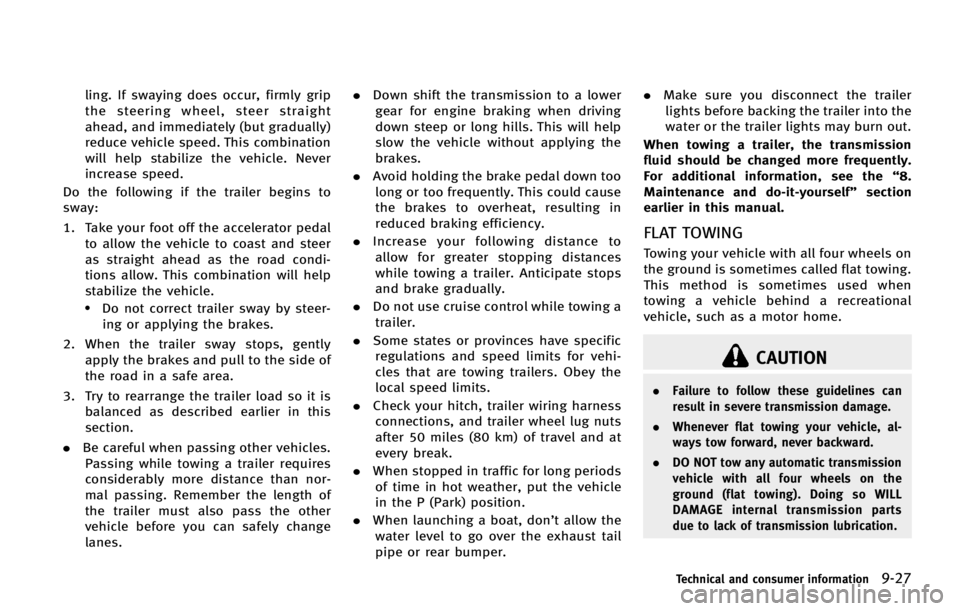
CAUTION
.Failure to follow these guidelines can
result in severe transmission damage.
. Whenever flat towing your vehicle, al-
ways tow forward, never backward.
. DO NOT tow any automatic transmission
vehicle with all four wheels on the
ground (flat towing). Doing so WILL
DAMAGE internal transmission parts
due to lack of transmission lubrication.
Technical and consumer information9-27